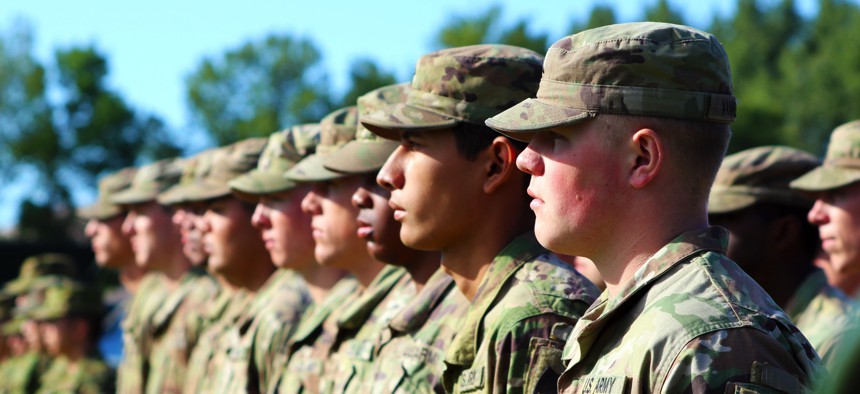
Soldiers from 17th Infantry Regiment stand together in formation during the opening ceremony for a training exercise at the Yakima Training Center, Washington, in 2018. U.S. Army
US Army Wants Data Analytics to Spot ‘Emerging Tech Leaders’
The Army plans to issue a call later this month through its Small Business Innovation Research program.
The Army plans to groom a new class of “emerging technology leaders” and wants to use data science and machine learning to identify the best soldiers for the job and where their talents are most sorely needed.
Fielding new technologies in the government and military space requires deep technical skills, an encyclopedic knowledge of federal policy and procurement and strong leadership willing to push through barriers and ensure sustained support. Having all these skills in one place usually requires a team of individuals. But having strong technologists in leadership roles can help bridge some of those gaps—especially between IT folks deep in the weeds and top brass floating high above.
Under a forthcoming solicitation under the Army’s Small Business Innovation Research, or SBIR, program, the branch will be asking small businesses for “solutions leveraging data science and/or machine learning techniques that will revolutionize how the Army recruits, develops, selects, and distributes talent across the force.”
The ideal solution will be a data analytics tool that can be used for:
- Skill identification: Unbiased identification and estimation of an individual’s skills based on standard CV/resume input. Identification and estimation of a job’s required skills based on a job description.
- Talent Recruitment: Strategies for targeting specific workforce sectors with prescribed sectors of elite talent.
- Talent Selection: Unbiased assessment and comparison regarding applicability of certain skillsets as compared to workforce requirements.
- Talent Development: Tell individuals what their skill deficiencies are and what jobs/opportunities would increase those skills.
- Talent Distribution: Predictive analytics for optimizing distribution of civilian, military and contractor talent across the force.
Those solutions will be used to identify emerging technology leaders, or ETLs, which the solicitation defines as uniformed experts who can bridge the gap between military operators and the Army’s scientists, engineers and technologists.
“Any submissions should be able to explain—in math, code, and/or theory—how skill identification and career planning capabilities work, demonstrate these functions with novel data, and identify limitations of the product—technical or data related,” the solicitation states.
As with most SBIR programs, the Army is approaching this project in multiple phases.
The first phase will offer up to $256,000 over four months to develop the theory of how such a solution would work. Vendors will have the ability to move to subsequent phases—including broader commercialization of their product—depending on their performance in Phase I.
Phase II will include production of a working prototype, with Phase III introducing more sophisticated technology, like machine learning, and focusing on reducing the workload of hiring and staffing managers. Solutions that make it to the third phase will also work on making the product commercially viable, with a focus on “applications in the hi-tech business sector.”
The Army is not looking for classified proposals, which cannot be accepted through the SBIR program, the notice states.
The official opportunity will be released Nov. 24, with bids openings Dec. 8. The program office will accept questions from potential proposers from Nov. 24 to Dec.23.
Proposals will be due by noon Jan. 12.




